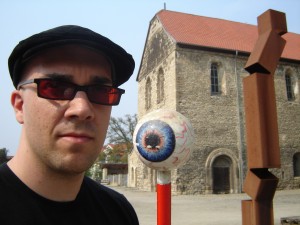In contemporary Western society, the stigma surrounding people with disabilities produces false representations of disabled people than what they would like to portray. Focusing in on a type of life narrative, disability memoirs, G.T. Couser argues that these writings have the “considerable potential to [be] counter stigmatizing” (Couser 31). Through disability memoirs, individuals write with the goal of eliminating this stigmatization in a hope that they will remove the marginalization disabled people are subject to.
One form of disability memoir is described by John Couser as being a “rhetoric of emancipation”, which serves to “contest received attitudes about disability” (Couser 33). An example lies in Cockeyed, a memoir by Ryan Knighton, who works to provide a counter narrative using a humorist approach to his blindness, that works to eliminate stigma by giving readers of the book a look into the life of a blind man. Throughout Cockeyed, we see Knighton making his experiences with blindness accessible and relatable to everyone. Initially in his writing, he accepts the stigma surrounding blindness and disabilities, wanting nothing to do with it, and ignoring it as long as possible. This acceptance of stigma can make him seem more relatable to his audience, who, whether they realize it or not, may subconsciously accept the stigma surrounding people with disabilities (PWD’s) as well. But after having to adopt a cane, Knighton comes to begin accepting his blindness, while at the same time still accepting some of the stigma society has placed on disabled people. In his acceptance of the cane, it urges the audience to also accept the use of a cane, and accept blindness, eliminating the marginalization of individuals with disabilities in society. Another example lies in the works of Jason DaSilva, a filmmaker who was diagnosed with multiple sclerosis, and has proceeded to produce multiple short films describing his experiences. In DaSilva’s work, he produces short films outlining and describing his experiences living as a disabled person, in a world mostly designed for the non-disabled. His works provide his audiences with insight into the life of someone who struggles with everyday tasks, like walking up stairs. These works by DaSilva work to eliminate stigma by outlining the problems he encounters in everyday life, but showing that he is a completely normal and relatable guy, not someone to be marginalized.
Ryan Knighton and Jason DaSilva’s works don’t directly appeal to their non-disabled audience in a confrontational way, but rather seem to attempt to eliminate stigma by creating a relatable character. This relatable character works to stop non-disabled people from looking at disabled people so differently, simply urging them to view PWD’s as a peer and complete equal. Both Knighton and DaSilva were born with no idea they would develop these disabilities, again producing an element of relatability in their works. Having lived both the non-disabled, and disabled life, their audience has the ability to directly relate and make the transition with them.
As new disability memoirs are produced, it will be interesting to investigate the ways in which they make appeals to their audience, eliminating stigma surrounding people with disabilities.
http://wheniwalk.com/about-the-film-makers/
http://wheniwalk.com/about-the-film-makers/
- Ryan Knighton
http://www.fortyfps.com/asap/media.htm
Works Cited: Couser, G. Thomas. Signifying Bodies : Disability in Contemporary Life Writing. University of Michigan Press, 2009. Web. 9 Nov. 2015.

